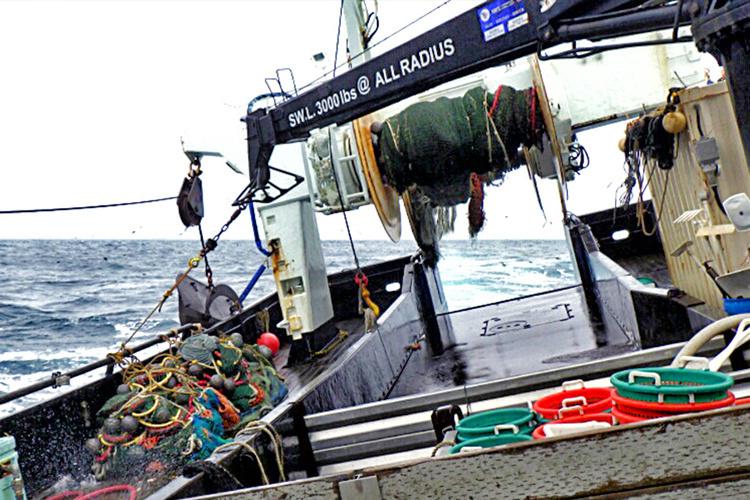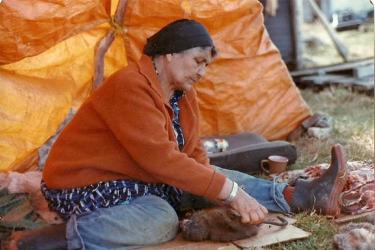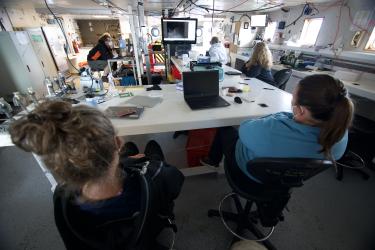That's a Cold Fish
Earlier in the cruise, Bob mentioned finding the edge of the Bering Sea cold pool. When in the most frigid heart of the cold pool, we find species like the marbled eelpout (Lycodes raridens), which is generally distributed only in the northern half of the Bering Sea shelf extending up into the Arctic Ocean. The marbled eelpout is especially well adapted to these chilly waters because it is capable of producing a protein that acts like antifreeze in their blood, so that even when temperatures on the bottom of the Bering Sea shelf are subzero, they can remain active and lively.
Another interesting fish we encounter up north is the butterfly sculpin (Hemilepidotus papilio), one of the many species of fish in the Bering Sea that can vary drastically in its appearance depending on whether it is a male or a female. If mature adults of the two sexes vary in size or shape, the phenomenon is called sexual dimorphism (di – double or twofold, and morph – size, shape or form). If the difference between sexes is based on color, it can also be called sexual dichromatism (‘chrome’ – color). Obviously, the butterfly sculpin is both! The male butterfly sculpin has large and elaborate radiating fins and is quite festive in its coloration. The female is pretty too, but she has less extravagant fins with hues of red and bronze. These differences play an important role in the mating and reproduction of the butterfly sculpin.

The marbled eelpout (Lycodes raridens) produces a protein in its body that acts as antifreeze.

The butterfly sculpin (Hemilepidotus papilio) is one of many species of fish in the Bering Sea where males and females vary drastically in their appearance.
Rougher Weather

A fairly large swell today, about 15-18 feet.
Earlier in this blog, Bob mentioned the preternaturally nice weather they encountered on Leg 1 of the survey. Those of us coming up for Leg 3 knew it couldn't last. From day one of this leg, we had some windy weather - nothing serious, just less comfortable. On our way out from Dutch Harbor, we discovered exactly what items weren’t tied down tightly! From picking up bowls of fruit from the galley floor, to keeping a cup of coffee upright, to putting a cod into a basket full of crab that wasn't there a moment ago, often the weather decides how we juggle our days.
On this leg, we used one of the unpleasant weather days to brush-up on safety awareness. The whole crew watched a training video series on safety-at-sea, and we paused to discuss personal experiences and share advice learned over the years on how to approach various scenarios such as fire, injuries, man overboard, and abandoning ship. To conclude, we staged a pretend drill where we had to react to a crew member who had fallen and injured their spine. We practiced the steps for how to respond to such an accident, bringing the appropriate medical equipment to the patient, recording vital signs, informing the captain, and preparing to do a helicopter evacuation of the patient from the vessel.
Over the years of conducting this survey on remote seas, we have learned that safety should be taught as a culture, not only as a response to an accident. Each one of us is responsible for our own safety as well as the safety of others on the ship.

The map shows the sampling grid for the 2017 eastern and northern Bering Sea shelf bottom trawl survey (June 1 and August 30, 2017). The map will be updated several times each week to show the progress of the survey vessels and the bottom temperature (°C) in each 20x20 nautical mile grid cell.

Caroline Robinson (Contractor) holds a marbled eelpout while Dan Nichol holds a male butterfly sculpin, both of which are commonly found in the northern waters of the Bering Sea shelf.
Meet the Bloggers

Bob Lauth
Bob Lauth has been a Fisheries Research Biologist for the NOAA Alaska Fisheries Science Center in Seattle for 26 years. Bob leads the Bering Sea Group, which is responsible for conducting summertime surveys of bottom fish, crabs, and other bottom-dwelling creatures in the offshore marine waters of Alaska. Fascinated by Jacques Cousteau as a kid, Bob moved from Chicago to the 'ever-green' Seattle in 1980 to become a marine biologist without the slightest idea how to earn a living. After working three years in a dive store, teaching scuba diving, and doing marine field trips with school kids in the Puget Sound, Bob learned about the 'fishy side’ to marine biology. He enrolled at the University of Washington School of Fisheries, earned a Master’s degree, and then worked for the Inter-American Tropical Tuna Commission at a remote marine lab in Central America before returning to the northwest with his wife to raise a family and pursue his career in fisheries.

Jason Conner
Jason Conner is a fishery biologist who researches the groundfish populations of the Bering Sea. He began his career with NOAA Fisheries in Woods Hole, MA, at the Northeast Fisheries Science Center, helping to record data on whale and seal populations in the Atlantic. He also spent two years in Gloucester, MA, working on fisheries data reporting systems for the Northeast Regional Office. Jason grew up in Denver, CO, but he has had a passion for the ocean since he was two years old. In his free time, Jason enjoys acting in community theater, playing ice hockey, and diving (with and without SCUBA).


